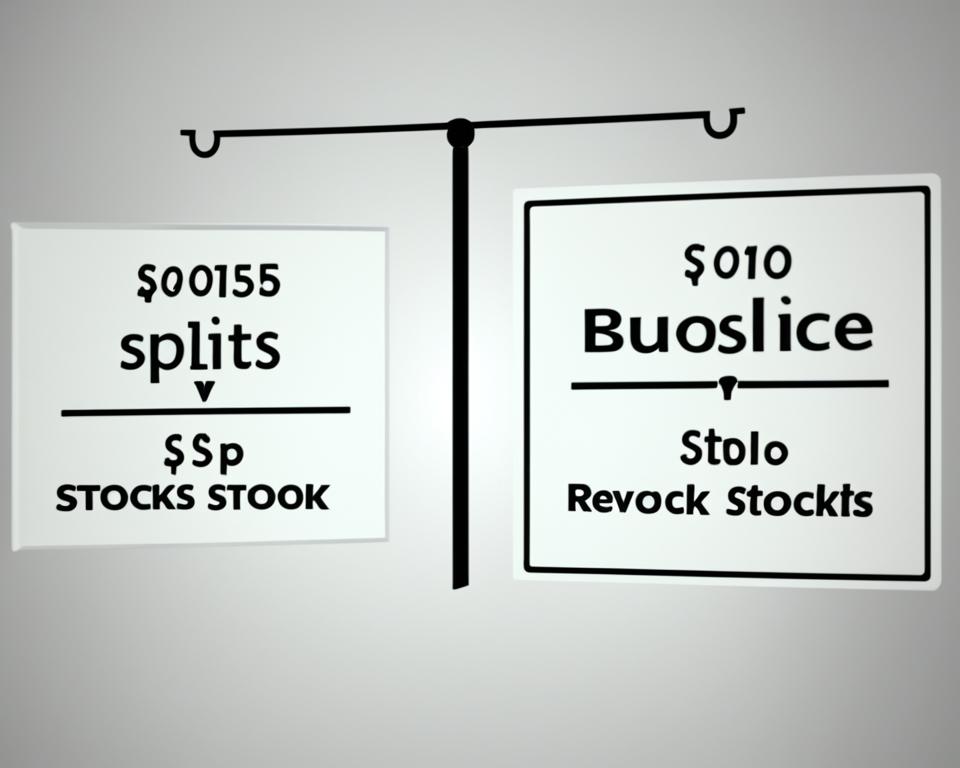Physical Address
304 North Cardinal St.
Dorchester Center, MA 02124
Physical Address
304 North Cardinal St.
Dorchester Center, MA 02124

Reverse Stock Splits: A Comprehensive Guide to Their Mechanics and Implications - Explore the processes, rationale, and consequences of reverse stock splits, a strategic corporate action impacting share prices and market capitalization.
Did you know a company can decrease its available shares and boost the price of each share? This is called a reverse stock split. It seems odd at first, but it’s a big deal for companies and their investors. This guide will unpack the details, the why, and the outcome of reverse stock splits. By the end, you’ll have a good handle on this complex move.
The stock market has been through a lot lately, thanks to the pandemic. In these changing times, companies are finding new ways to stay afloat and thrive. One tactic they might use is a reverse stock split. This may sound a bit tricky, but it’s easy to get. A reverse stock split is when a company decreases its share count to make the price of each share rise. It’s more than just math; this choice impacts both the company and its investors a lot.
Reverse stock splits happen when a company changes its shares so that there are fewer, but they cost more. This is the opposite of a regular stock split where a single share becomes many cheaper ones. During a reverse stock split, the company combines its shares by a chosen number like 1-for-5 or 1-for-10. The goal is to make each share more expensive without affecting the company’s total value.
Companies consider reverse stock splits for several reasons. They might want to keep their share price high to avoid getting removed from big stock markets. This can make the company look better in the market and draw in more significant investors who prefer higher-priced stocks. It can also help meet certain legal rules about the number or value of shares in some places.
In a reverse stock split, the company puts together existing shares at a set rate, like 1-for-5 or 1-for-10. This change means that for every 5 or 10 shares an investor used to have, they now have just 1. But that single share is worth more. So, the value of the investment stays the same.
Common reverse stock split ratios are often 1-for-5, 1-for-10, 1-for-20, and 1-for-25. Yet, it can be any number. These ratios show how many new shares investors get for their old ones. In a 1-for-5 reverse split, an investor’s 5 shares become 1. In a 1-for-10 split, 10 shares turn into 1.
To understand a reverse stock split‘s effect, divide total shares by the split ratio. If someone had 500 shares in a 1-for-5 reverse split, it’d become 100 shares. Each share would be worth $50, keeping the total value at $5,000.
A reverse split stock calculator helps investors. By entering share amounts, prices, and the split ratio, it shows how the split affects shares and prices. This makes it clear how the investment changes.

A reverse stock split immediately boosts the share price. This boost comes from lowering the number of shares. Yet, the company’s total value stays the same. Such a rise in price helps avoid being delisted by big stock exchanges.
After a reverse stock split, the share price goes up. This happens because the shares available decrease, but the company’s worth stays steady. Such steps are taken to keep meeting the stock exchange’s higher share price rules.
Yet, the effects of reverse stock splits can last longer. This move might signal struggles to the market or a shortfall in growing share prices naturally. It could lead to more people selling their shares, causing prices to slide down.
Reverse stock splits are done for several important reasons. They help companies stay listed on big stock exchanges. They also make a company look better in the market. This can attract big investors who might not buy very cheap stocks. Sometimes, companies do this to follow laws about how many shares can be out there or their prices.
In a reverse stock split, the company first decides to do it. Then, they get the okay from shareholders, if they need to. Next, they carry out the split. This means they combine existing shares at a set ratio. This makes the number of shares go down and the share price go up.
Reverse stock splits can affect both shareholders and the market. Even though what a shareholder owns doesn’t change right away, the company’s future might. How the market reacts to the split can be a big deal. Plus, a reverse split can bring chances and risks to investors, depending on how the market takes the news.
Reverse stock splits and regular stock splits go different ways. A Reverse Stock Split cuts the shares but increases the price. A Regular Stock Split ups the shares but brings the price down. They are done for very different reasons.
Companies may use reverse splits to check off exchange rules, look better for the market, or pull in big investors who can’t buy low-value stocks. On the other hand, regular splits help make stocks more available and interesting to everyday investors. This helps increase liquidity and accessibility.
Both types of splits can affect how easily a stock can be bought or sold. Regular splits often make trading smoother and the stock more appealing, while reducing the bid-ask gap. But, Reverse Splits might make a stock harder to sell, since there are fewer shares, hurting the liquidity.

| Characteristic | Reverse Stock Splits | Regular Stock Splits |
|---|---|---|
| Direction | Reduces the number of shares, increases share price | Increases the number of shares, decreases share price |
| Objectives | Meet listing requirements, enhance market reputation, attract institutional investors | Improve liquidity and accessibility for retail investors |
| Liquidity Impact | Can decrease liquidity and widen bid-ask spread | Tends to improve liquidity and potentially narrow bid-ask spread |
| Trading Considerations | May negatively impact trading dynamics and market perception | Can make the stock more attractive for trading |
Looking at. past reverse stock splits offers key insights. We can learn from examples like General Electric’s (GE) 1-for-8 split in August 2021. This was followed by a drop in their stock price. On the other hand, a smaller split of 1000-for-1281 in January 2023 saw their stock price go up. By studying these cases, we can guess how the market might react. This knowledge can help in making smart choices about reverse stock splits.
The way the market reacts to reverse stock splits changes a lot. It depends on the company’s situation and the overall economy. Sometimes, these splits hint at problems like financial trouble. This can make the stock price fall more and lose favor with investors. Yet, if a split is seen as a sure way to follow stock market rules or interest new types of investors, it might be looked on more positively, at least in the beginning.

Reverse stock splits can have advantages for companies. They can make sure the company’s stock meets the minimum price needed to stay on big stock markets. This can prevent the stock from being removed from trading. It can also improve the company’s image in the market. Plus, it can attract more interest from big investors who can only buy stocks above a certain price. All of this helps the company keep access to money markets and possibly grow its total stock value.
Reverse stock splits are helpful for hitting the right share price for major stock exchanges. For example, the NYSE and Nasdaq have set price rules to avoid delisting stocks. By doing a reverse split, a company can keep trading on these markets. It can make the company look better in the investors’ eyes. And it can pull in bigger investors who might only be able to buy more expensive stocks.
This could help the company raise its market capitalization. That’s the total value of all its shares. So, it’s better for the company’s overall value too. But there are also downsides to reverse stock splits.
Reverse stock splits might not always be good news. Some investors might see it as a red flag. They might think the company is struggling, or it’s not growing its value on its own. This could lead to more people selling their stock. Then, the stock price could fall even more. This is because fewer shares are available, which might not be good for everyone.
Also, these reverse splits can sometimes make it harder to buy and sell the stock. With fewer shares moving around, trading can slow down. This can cause the difference between buying and selling prices to get bigger. Some investors might find this stock less appealing because of these challenges.

Reverse stock splits have to follow rules from big stock markets like the
and Nasdaq. They usually say a company’s share price can’t go below $5. If it does, the company might do a reverse split to fix it. This helps keep their stock listed and not risk being removed.
When a company does a reverse stock split, they must meet the rules of the stock markets they’re part of. Keeping the share price high enough is key. A reverse split can help companies get their share price where it needs to be. This keeps them in the stock market.
Along with stock market rules, companies doing reverse splits must follow SEC reporting guidelines. This means they have to tell investors why they’re doing the split and what it means for the company. Following these rules helps keep the market honest and builds trust with investors.
For investors, knowing about reverse stock splits is key in evaluating risks and opportunities. After a reverse split, the value of what you own might not change right away. Yet, the company’s path ahead could be swayed by how the market reacts. It’s smart to look into why a company is doing a reverse split. This lets you see how it might affect the company later on. Also, it helps you understand the chances and dangers this move brings.
The “Waterfall Trading System” was born from looking at past reverse stock splits. This method aims to make gains by short selling stocks that often keep going down. It takes advantage of the bearish market mood and the usual drops in trading volume after a reverse split. Testing this method on historical data has shown it could lead to good profits.
Evaluating trading methods for reverse split stocks needs to include backtesting on split-adjusted data. This step makes sure historical prices and trading volume accurately show the stock’s true path. Right after a reverse split, the stock charts might not look right without using split-adjusted data. By doing this, traders can create strategies that truly understand the effects of reverse stock splits.
Reverse stock splits are a complex corporate move. They impact companies, their investors, and the market at large. It’s key for shareholders to grasp why these splits happen, their effects, and how they can respond. Tools like reverse split stock calculators and past case studies are helpful. They assist investors in understanding and acting wisely amidst a reverse split.
When a company decides on a reverse stock split, they’re making a strategic move. This choice can greatly alter how a company looks and functions in the eyes of its shareholders. It’s important for investors to consider the company’s goals, finances, and how others feel about it. Such insight guides them in making wise choices during a reverse split.
In the end, reverse stock splits are significant for companies and their owners. By grasping the full picture and crafting smart trading and investment strategies, investors position themselves well. They can seize opportunities or lessen the impact of risks. This approach allows them to move through volatile markets successfully, even when facing reverse splits.